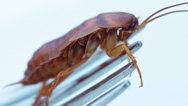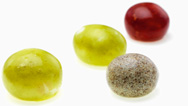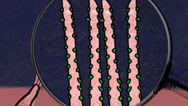Neuroscience of Taste
- Posted 10.31.12
- NOVA scienceNOW
Why are some foods—like chocolate chip cookies—delectable, while others—like cookies made with mealworms—disgusting? You might think you understand what makes something sweet, salty, or bitter, but a secretive corps of flavor makers, the ones who concoct the food in our supermarkets and the drinks in our favorite coffee shops, know the real truth: Not only is our perception of flavor far more complex than we imagine, involving all of our senses and even our memories, but once you master the secrets of flavor, it's easy to fool the taste buds.
Transcript
Can I Eat That?
PBS Airdate: October 31, 2012
DAVID POGUE: For me, the most important thing about food is, of course, the way it tastes. But how come different things taste good to different people? Like some people go nuts for French fries, while others salivate over salad.
I want to know what's going on, so I've come to San Francisco on a mission and it's not just to eat at great restaurants.
Hi.
MONICA MARTINEZ (Don Bugito): Hi.
DAVID POGUE: I'm David.
MONICA MARTINEZ: Monica.
DAVID POGUE: Monica Martinez is cooking up something new that has me freaked out!
MONICA MARTINEZ: So, this is my kitchen.
DAVID POGUE: The central ingredients have just arrived from FedEx?
Please don't tell me these are air holes?
MONICA MARTINEZ: Yes.
DAVID POGUE: They're alive?
MONICA MARTINEZ: They are alive.
DAVID POGUE: Oh, god! Oh, no, no, no. They're writhing!
And it's not just wax moth larva. In box number two…
MONICA MARTINEZ: This has to be done fast, because they jump out.
DAVID POGUE: …crickets. That's…I have no words.
Monica is drawing on her Mexican heritage to develop a signature snack and prepping for tonight's foodie event, called "Off the Grid."
MONICA MARTINEZ: When I cook them, I just pan fry them.
DAVID POGUE: The recipe is simple: take two homemade tostadas, add avocado and zucchini and then, for the bit that makes my taste buds tremble, a generous sprinkling of crickets.
Here's to all our six-legged friends!
MONICA MARTINEZ: They taste amazing! Crickets have their own flavor, so they taste really good.
DAVID POGUE: It's not the food, it's the concept. It's the thought of what I just saw come out of that hideous FedEx box.
MONICA MARTINEZ: Yes.
DAVID POGUE: But if you hadn't told me, I'd say these were some of the best tacos I've ever had.
Eating bugs reveals there is more to taste than just taste buds. So what really does go on?
BARB STUCKEY: Would you mind taping your nose?
DAVID POGUE: Excuse me?
BARB STUCKEY: Just close it, like this. I'll do it with you. You're just going to take one of your nostrils and kind of plug it, and then…
DAVID POGUE: Okay.
BARB STUCKEY: …plug the other one, and…
DAVID POGUE: Oh, my gosh.
Barb Stuckey is a professional taster for a food product company called Mattson, near San Francisco.
Okay.
BARB STUCKEY: So, now, go ahead and swish it around your mouth.
DAVID POGUE: Okay: water.
BARB STUCKEY: Take another swish, and this time, when you are swishing, let's take the tape off.
DAVID POGUE: Okay. Oh, my gosh, it turned into brown butter.
BARB STUCKEY: Most of flavor comes through your nose.
DAVID POGUE: …freaking me out! Wait a minute, but it was inside my mouth. I couldn't have smelled it.
Oh yes, I could. Inside our mouths there is a back channel to our smell receptors. Volatile molecules, or vapors, rise off food in our mouths and trigger our sense of smell.
But if your nose is blocked, the vapors aren't pulled up into the nasal cavity and you don't smell them. It turns out our nose plays a big role in the creation of flavor, the total experience of food.
BARB STUCKEY: It feels like the flavor is coming from your mouth, but, in fact, it's coming from your mouth through your nose, and the aromas are detected in your nose.
DAVID POGUE: And smell isn't our only sense at work.
Barb asks me to try a new juice they've just created.
It's definitely not fresh-squeezed.
BARB STUCKEY: What would you say if I told you that was apple juice?
DAVID POGUE: Wait a minute. You are doing some kind of brain meld on me. This is clearly orange juice, but it tastes like apple juice, so what have you done here?
BARB STUCKEY: All we have done is taken apple juice and added a little bit of orange color.
DAVID POGUE: You're kidding.
BARB STUCKEY: So it looks like orange juice.
DAVID POGUE: Gosh, I am such a sucker! I can't believe I fell for that. It is perfectly good apple juice.
BARB STUCKEY: It is very good apple juice, yeah.
DAVID POGUE: Barb says not only smell and vision, but even sound can influence taste. So I'm blindfolded to see if cold water sounds different from hot water.
Wait a minute. I could tell that the second one was hot! How could I tell that the second one was hot?
BARB STUCKEY: All right, take your blindfold off. The second one was hot.
DAVID POGUE: I know. I could hear that it was hot, but that makes no sense! It had a hot water sound.
Believe it or not, hot water has a different pitch when it hits the cup than cold water does.
BARB STUCKEY: Everyone gets it right.
Sound gives us information about, not just temperature, but freshness, crispiness, crunchiness, texture, fat content.
DAVID POGUE: You don't actually put thought into the sound these foods are going to make do you?
BARB STUCKEY: Of course, very much so.
DAVID POGUE: Here at Mattson, they're trying to make treats so delicious that you will crave them and buy them.
And, Honey, there's no fat! There's no sugar!
To do so, they use their understanding of how flavor works and food science to engineer flavors that appeal to all your senses.
BARB STUCKEY: Flavor, that concept, comes through many different senses. Really, when you're experiencing food, and you say you like the taste of something, you really like the way it looks, the way it feels, the way it sounds, the way it smells and the way it tastes.
LINDA BARTOSHUK: You have a gorgeous tongue.
DAVID POGUE: Thank you.
To get a better understanding of the difference between taste and flavor, I'm having my tongue examined by the guru of taste: Linda Bartoshuk, of the University of Florida.
LINDA BARTOSHUK: You never see taste buds. They are not visible on the tongue. Taste buds are buried in the tissue of this little mushroom-like structure, fungiform papillae.
DAVID POGUE: Do I have that?
LINDA BARTOSHUK: Yes.
DAVID POGUE: Is there a cure for it?
LINDA BARTOSHUK: You don't want a cure for it.
DAVID POGUE: Okay.
LINDA BARTOSHUK: Those things are really good.
DAVID POGUE: The surface of your tongue is covered with mushroom-shaped structures called fungiform papillae, which house the taste buds.
Bartoshuk uses a card with a hole about the size of a pea, and then counts the number of spots on my tongue. Her blue dye reveals the fungiform papillae.
LINDA BARTOSHUK: Oh, wow.
DAVID POGUE: Some people taste things more strongly for the simple reason that they have more taste buds. Bartoshuk calls them "supertasters."
LINDA BARTOSHUK: Wow. You are up between 50 and 60 fungiform papillae. This is very, very high.
DAVID POGUE: (With mouth open trying to say "Really?") Weawwy?
LINDA BARTOSHUK: From what I can see now, you definitely look like a supertaster. So that's a pretty well-endowed tongue.
DAVID POGUE: Sweet! Literally. To see how it works, let's zoom into a taste bud, where there is a sweet receptor. If we drink some of that orange apple juice, the sugar molecules in it bind with a sweet receptor. That then sets off a series of chain reactions that sends a signal to the brain that you are eating something sweet.
LINDA BARTOSHUK: When you eat a piece of candy, you're experiencing more sweet than I am. And you have, not only more taste buds, but you, in addition, have more pain fibers, because every taste bud is surrounded by a basket of pain fibers. So if you eat jalapeño peppers, you are going to be at least twice, perhaps three times as intense burning as I would get.
DAVID POGUE: That explains so much. I can't tell you the number of dinners I have had where everyone is like, "Oh, you are so a hot pepper wuss, Pogue."
LINDA BARTOSHUK: Yeah.
DAVID POGUE: It's not that. It is just that I am suffering four times more!
LINDA BARTOSHUK: Yes, yes. You are experiencing considerably more burn.
DAVID POGUE: I think I got it all!
Certain tastes are hardwired in your biology. These basic tastes are the ones that trigger receptors that you have on your tongue: sweet, sour, bitter and salty. Some also think that the savory flavor of meat or cheese is a fifth basic taste, called "umami."
LINDA BARTOSHUK: The brain is built to make sure you experience those tastes. It's wired that way. And the reason you are wired to like sweet is so that a newborn baby will nurse immediately, without having to learn, because mother's milk is sweet. At the same time, the reason you want to build in a dislike for bitter, is so that, if you put anything in a child's mouth that's toxic—and most toxins are bitter—the child will spit it out and make a fuss.
DAVID POGUE: Bartoshuk says these basic tastes were key in our evolution.
LINDA BARTOSHUK: The taste system evolved as the true nutritional sense. It solves problems that, if you don't solve them immediately, you die.
DAVID POGUE: As basic as flavor is, there is an awful lot we don't fully understand about how it works. And at research centers and universities there are a lot of people working to figure it out.
Gordon Shepherd, of Yale University, is mapping how our brain gets involved in processing flavor.
GORDON SHEPHERD (Yale University): Flavor's not in the food that we eat. Flavor is not in the molecules. The perception of flavor is created by the pathways in the brain.
DAVID POGUE: Thankfully, instead of dissecting my brain to prove his point, Shepherd kindly uses colored tape.
GORDON SHEPHERD: This is representing the pathway of smell. Next comes taste.
DAVID POGUE: Each different color represents the pathway inside the brain that information from our different senses travels, like the signal from the taste buds.
GORDON SHEPHERD: Here we go with sight, hearing, touch.
DAVID POGUE: These pathways run throughout the brain.
It's mind-blowing. You are saying that the simple act of eating, the simple pleasure of eating something, involves circuits all over my brain, zipping everywhere at once.
GORDON SHEPHERD: The way that the brain creates flavor engages more of the brain than almost any other behavior that we take part in.
DAVID POGUE: As we try to understand the power of the brain in creating flavors and creating our cravings for those flavors, the science of taste is moving into new frontiers.
LINDA BARTOSHUK: The problem is our evolutionary mechanisms did a great job to make us survive, but evolution didn't know we were going to live so long, eventually.
DAVID POGUE: Our system of taste evolved for a world where food was scarce and starvation was a real threat. In today's world, the bigger problem is coping with the abundance of food; one where our evolutionary craving for fats and sugars can be a liability. Even so, delicious foods are one of life's great pleasures, even foods we never thought would be delicious.
Monica! I can't believe you have a line here.
MONICA MARTINEZ: I don't believe that.
DAVID POGUE: Maybe I was giving the bugs short shrift. Maybe there's something to this.
New research shows that the more choice we have, the more likely we are to overeat, like gorging at a buffet or here at the San Francisco foodie event, Off the Grid, because variety sparks our interest.
One bacon and egg popsicle!
It's like what Gordon Shepherd said as he was putting colored tape on my head: experiencing flavor probably engages more of our brain than almost any other activity we do.
Wow, so amazing.
Shepherd believes that would include exercise, work or even sex.
Basically I think what it boils down to is superior lubricity and retronasal olfaction.
Think of that next time you take a bite!
Think sugar receptors are only on your tongue?
They also exist…
in your intestine!
Research in mice reveals that receptors in the gut sense sugar…
And send messages to the brain, saying, "Eat more of that!"
So be careful about "listening to your gut."
It's possible that it likes sugar and is not afraid to say so.
Credits
Can I Eat That?
- HOST
- David Pogue
- WRITTEN, PRODUCED AND DIRECTED BY
- Doug Hamilton
Nathan Myhrvold Profile
- WRITTEN BY
- Jesse Sweet
- PRODUCED BY
- Joshua Seftel & Jesse Sweet
- DIRECTED BY
- Joshua Seftel
NOVA scienceNOW
- EXECUTIVE PRODUCER
- Julia Cort
- PRODUCTION MANAGER
- Stephanie Mills
- BUSINESS MANAGER
- Elizabeth Benjes
- INTERSTITIALS PRODUCED BY
- Brian Edgerton
- ORIGINAL MUSIC BY
- Christopher Rife
- SENIOR RESEARCHER
- Kate Becker
- CAN I EAT THAT? EDITED BY
- Geoff Gruetzmacher
Rob Tinworth - NATHAN MYHRVOLD PROFILE EDITED BY
- Jawad Metni
- PRODUCTION SUPERVISOR
- Jill Landaker Grunes
- ASSOCIATE PRODUCERS
- Jessica Harrop
Catherine Bright - ARCHIVAL RESEARCH
- Minna Kane
Adam Talaid - PRODUCTION COORDINATOR
- Seandor Szeles
- CAMERA
- Dan Krauss
Steve McCarthy
Jason Longo
Rich White
Rob Tinworth
Vicente Franco - SOUND RECORDISTS
- Gabe Monts
Jim Choi
Mario Cardenas
Brad Schirmer
Rick Albright
Charles Tomaras - ANIMATION
- Mitch Butler
- ADDITIONAL MUSIC
- Scorekeeper's Music
- ASSISTANT EDITORS
- Rob Chapman
Steve Benjamin - ONLINE EDITOR AND COLORIST
- Jim Ferguson
- AUDIO MIX
- Heart Punch Studio, Inc.
- PRODUCTION ASSISTANT
- Norman Tumolva
- POST PRODUCTION ASSISTANT
- Olaf Steel
- ARCHIVAL MATERIAL
- George Zaidan
Shutterstock Images LLC
Getty Images, Inc.
Library of Congress, Prints & Photographs Division
Western History/Genealogy Department, Denver Public Library - SPECIAL THANKS
- Harvard Museum of Comparative Zoology
Yale University
FLIR Cameras
LoCura
Gilbert Pilgram
Monell Chemical Senses Center
Johan Lundstrom
Sarah Pilkenton
The Cooking Lab / Intellectual Ventures
Whole Foods Market, Bellevue
Wayt Gibbs
Maxime Bilet
Chris Young
Ryan Matthew Smith - ADVISORS
- Sangeeta Bhatia
Charles Jennings
Richard Lifton
Neil Shubin
Rudy Tanzi - NOVA SERIES GRAPHICS
- yU + co.
- NOVA THEME MUSIC
- Walter Werzowa
John Luker
Musikvergnuegen, Inc. - ADDITIONAL NOVA THEME MUSIC
- Ray Loring
Rob Morsberger - POST PRODUCTION ONLINE EDITOR
- Spencer Gentry
- CLOSED CAPTIONING
- The Caption Center
- MARKETING AND PUBLICITY
- Karen Laverty
- PUBLICITY
- Eileen Campion
Victoria Louie - NOVA ADMINISTRATOR
- Kristen Sommerhalter
- PRODUCTION COORDINATOR
- Linda Callahan
- PARALEGAL
- Sarah Erlandson
- TALENT RELATIONS
- Scott Kardel, Esq.
Janice Flood - LEGAL COUNSEL
- Susan Rosen
- DIRECTOR OF EDUCATION
- Rachel Connolly
- DIGITAL PROJECTS MANAGER
- Kristine Allington
- DIRECTOR OF NEW MEDIA
- Lauren Aguirre
- ASSOCIATE PRODUCER
POST PRODUCTION - Patrick Carey
- POST PRODUCTION EDITOR
- Rebecca Nieto
- POST PRODUCTION MANAGER
- Nathan Gunner
- COMPLIANCE MANAGER
- Linzy Emery
- DEVELOPMENT PRODUCERS
- Pamela Rosenstein
David Condon - COORDINATING PRODUCER
- Laurie Cahalane
- SENIOR SCIENCE EDITOR
- Evan Hadingham
- SENIOR PRODUCER
- Chris Schmidt
- SENIOR SERIES PRODUCER
- Melanie Wallace
- MANAGING DIRECTOR
- Alan Ritsko
- SENIOR EXECUTIVE PRODUCER
- Paula S. Apsell
NOVA scienceNOW is a trademark of the WGBH Educational Foundation
NOVA scienceNOW is produced for WGBH/Boston
This material is based upon work supported by the National Science Foundation under Grant No. 0917517. Any opinions, findings, and conclusions or recommendations expressed in this material are those of the author(s) and do not necessarily reflect the views of the National Science Foundation.
© 2012 WGBH Educational Foundation
All rights reserved
Image
- (David Pogue's tongue)
- © WGBH Educational Foundation
Participants
- Linda Bartoshuk
- Smell & Taste Center, University of Florida
- Monica Martinez
- Don Bugito
- Gordon M. Shepherd
- Yale University
- Barb Stuckey
- Mattson
Related Links
-

Can I Eat That?
Learn about the neuroscience of taste, why we cook our food, what makes a Thanksgiving turkey savory, and more.
-

Five Reasons to Eat Insects
Save room for bugs! They're the future of green cuisine.
-

Packaging You Can Eat
A team of chefs, chemists, and designers introduce foods and beverages wrapped in edible shells.
-

Tour the Tongue
Learn how our sense of taste works, and why we evolved the ability to detect flavors like bitter and sweet.



